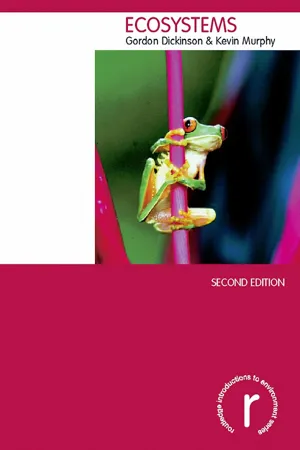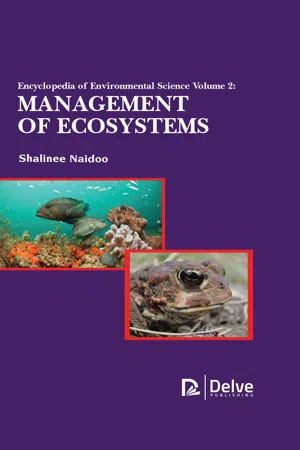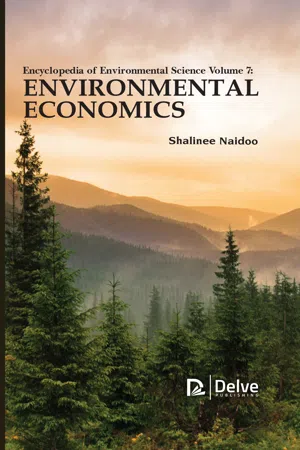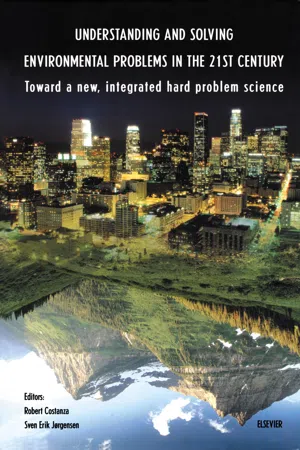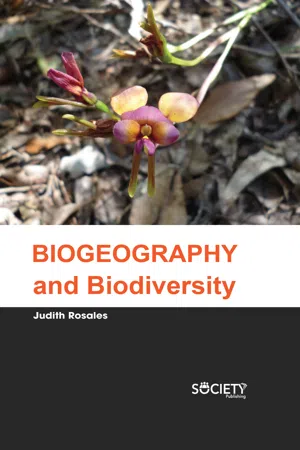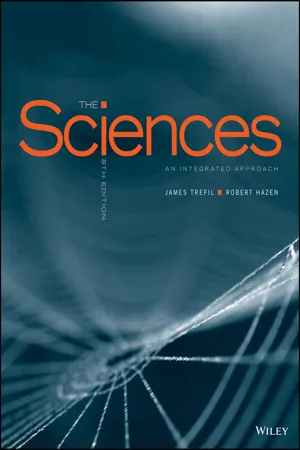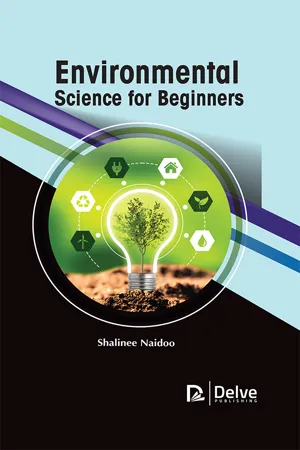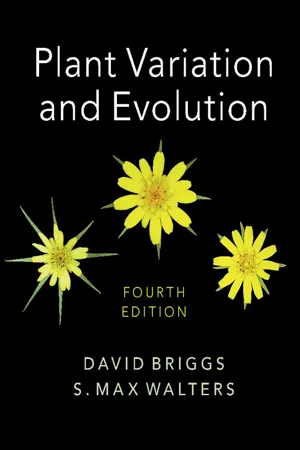Biological Sciences
Human Impact on Ecosystems
Human impact on ecosystems refers to the ways in which human activities affect the balance and functioning of natural environments. This can include habitat destruction, pollution, introduction of invasive species, and overexploitation of resources. These impacts can lead to loss of biodiversity, disruption of ecological processes, and ultimately, negative consequences for both the environment and human well-being.
Written by Perlego with AI-assistance
Related key terms
1 of 5
10 Key excerpts on "Human Impact on Ecosystems"
- eBook - ePub
- Gordon Dickinson, Kevin Murphy(Authors)
- 2007(Publication Date)
- Routledge(Publisher)
9 Human impacts on ecosystems: humans as an ecological factor
Human impacts on ecosystems are as old as the human species. However, following industrialisation, with the consequent increase in numbers of people and their ability to modify the biosphere, both the extent and consequences of human impacts on ecosystems have accelerated. Impacts resulting from human activities occur in all parts of the biosphere, and at all kinds of temporal and spatial scales. This chapter covers:- General nature of human impacts on ecosystems
- Fire
- Introduced species
- Recreation
- Sustainable development
Human impacts: an old and new issue
Human beings are part of the biosphere. In most parts of the world, humans are the dominant organisms. The previous chapters have shown that we share the biosphere with millions of other species. We also depend, as much as any other living creature, on the functioning of ecosystems in the biosphere to support our existence. Unlike all other species, people have the unique ability to affect profoundly the nature and functioning of ecosystems throughout the biosphere. This chapter is concerned with anthropogenic effects on the trophic structure and functioning of ecosystems. This is linked to functional ecology by examining the changes that take place in species composition in the affected ecosystems. In some ways humans may be considered as simply another biological species, albeit one that exists in very large numbers. But we are also the species that is capable of the most profound ecological and environmental impacts. The scale and importance of human impacts, together with the fact that (not unreasonably) humans tend to view the world from a human perspective, means that it is important to separate human roles in ecosystems from those of other species. There are now about 6,000 million individual Homo sapiens - eBook - PDF
Encyclopedia of Environmental Science Vol2
Management of Ecosystems
- Shalinee Naidoo(Author)
- 2019(Publication Date)
- Delve Publishing(Publisher)
HUMAN INFLUENCES ON THE ECOSYSTEM 4 CHAPTER Human beings have continuously manipulated the environment since they first inhabited the Earth more than 2 million years ago. Through various anthropogenic effects such as the development of cities, building of industrial areas, deforestation, enhanced agricultural practices and excessive technological advances, a huge impact on various ecosystems have been exerted. This, in turn, has rendered a number of species extinct together with the generation of large amounts of waste and pollution. Out of all the living species which essentially form an important part of an ecosystem, humans have brought about the maximum effects, both positive and negative and while their actions are harmful (and sometimes beneficial), rising concern has developed due to the shortage of awareness and ignorance (Figure 4.1). Much of these effects occur either directly or indirectly and involve the use of excessive resources and have subsequently affected different ecosystems in various ways. Management of Ecosystems 30 Figure 4.1: Schematic diagram showing the direct and indirect impacts of hu-man activities on various ecosystems, Source: Adopted from Vitousek, Mooney, Lubchenco, and Melillo (1997). Harmful human activities which are known to disturb the biodiversity cycle and subsequent ecosystems can be grouped into three major categories. These include (i) land transformation and degradation (figure), (ii) activities affecting global biogeochemistry by overloading nutrient cycles or altering their rate, and (iii) activities that result in biotic additions (species invasions) and losses (hunting and fishing). With the continuous increase in population numbers, more land is needed for housing and related supplies. This often leads to land transformation activities which in turn lead to the cutting down and clearing of forests to make more space. Hence land transformation is often the reason behind enhanced deforestation activities. - eBook - PDF
Encyclopedia of Environmental Science Vol 7
Environmental Economics
- Shalinee Naidoo(Author)
- 2019(Publication Date)
- Delve Publishing(Publisher)
LINKING THE ECOSYSTEM AND ECONOMICS CHAPTER 7 7.1. HUMAN INFLUENCES ON THE ECOSYSTEM The influence of humans on the environment has been apparent for centuries. Increases in various anthropogenic activities has resulted in a huge impact on various ecosystems. In addition to large amounts of waste and pollution, this has further rendered a number of species extinct. Out of all the living species which essentially form an important part of an ecosystem, humans have brought about the maximum effects, both positive and negative and while their actions are harmful (and sometimes beneficial), rising concern has developed due to the shortage of awareness and ignorance (Figure 7.1). these positive and negative effects occur either directly or indirectly, each of which having affected different ecosystems in various ways. Environmental Economics 44 Figure 7.1: Schematic diagram showing the direct and indirect impacts of hu-man activities on various ecosystems, Source : Adopted from Vitousek, Mooney, Lubchenco, and Melillo (1997). Human activities that are thought to be harmful and which are known to disturb the biodiversity cycle and subsequent ecosystems can be grouped into three major categories. These include (i) land transformation and degradation, (ii) activities affecting global biogeochemistry by overloading nutrient cycles or altering their rate, and (iii) activities that result in biotic additions (species invasions) and losses (hunting and fishing). Increasing population numbers has resulted in an increased need for housing, which in turn has led to land transformation activities such as the cutting down and clearing of forests in an attempt to make more space. This essentially has led to enhanced deforestation activities and has resulted in devastating effects on wildlife. - eBook - PDF
Understanding and Solving Environmental Problems in the 21st Century
Toward a New, Integrated Hard Problem Science
- R. Costanza, S.E. Jorgensen(Authors)
- 2002(Publication Date)
- Elsevier Science(Publisher)
Finally, religion, culture and other types of belief can also affect the perception and understanding of humans in relation to their environment. In the Judeo-Christian tradition, humans are assumed to have dominion over nature (Harper, 2001). This belief encourages people to consider humans as separate from the rest of nature, and as having dominance over nature. It is often this perception that has encouraged the degradation and demise of our life support systems. One may ask, however, why it is not recognised that this may also be the demise of our own species and culture. The answer might lie in the optimistic belief that new technologies will come to the rescue (as they have in the past). This undying faith in technology has very little evidence supporting it however, as often attempts to mitigate ecosystem degradation has simply resulted in transferring the problem elsewhere (e.g., applying fertilizers to compensate for declines in soil fertility can often lead to contaminated ground water, rivers, lakes, etc.) (Rapport et al., 2001). It is now essential to describe some examples showing how human activities affect ecosystems, which in return influence human health. In the next three sections, global problems related to human and ecosystem health and the links between humans and ecosystems are explored. The topics discussed here are climate change, agrosystems and food production, and biodiversity and declining productive capacity. Although there are many more issues related to ecosystem health and human health, we have chosen to consider these as they have significant global implications. They pose challenges however, not only at the global policy level, but as well, at the regional and local scales. 4. Climate change Human dependency on the burning of fossil fuel has increased in the past century. With greater population size and increasing economic activities, emissions into the atmosphere have reached levels never recorded before in human history. - eBook - PDF
- Judith Rosales(Author)
- 2019(Publication Date)
- Society Publishing(Publisher)
In particular, because one of the most important services is the regulation of global warming and the effects of climate change, thus, this chapter elaborates more on the direct and underlying causes of biodiversity loss. It also evaluates how the biodiversity loss impacts the lives of human beings. Furthermore, the role of biodiversity in ecosystem stability and conservation is also discussed. 4.1 INTRODUCTION The wellbeing of humans is dependent on the nature that provides a variety of advantages such as food, clean water, carbon, soil, medicines, tree shade, fibers, charcoal, among many others. Without these ecosystem services present today in the natural flow in a continuous manner, the human society cannot be able to keep flourishing. Biodiversity is a glorious contribution of nature on earth. Ecosystem services provide humans food and water and other goods without charging any cost. Therefore, these are rarely identified by our present economic scope. Therefore, there has been a noticeable decline in biodiversity as the ecosystems of the earth are continuously destroyed. On the other hand, biodiversity is essential to maintain different services of the ecosystems such as the production of food, regulation of atmosphere’s chemical composition, the supply of raw materials, recycling of nutrients, provision of water and natural control of flora and fauna’s population. Biodiversity is also essential for services such as genetic resource usage and various leisure activities, but nowadays it is evident that the world has already lost a considerable amount of its biodiversity. This loss of biodiversity has an adverse effect on the lives of human beings but also in affecting economies of the states as it imposes a pressure on the prices of food and commodities. - eBook - PDF
The Sciences
An Integrated Approach
- James Trefil, Robert M. Hazen(Authors)
- 2016(Publication Date)
- Wiley(Publisher)
19 Ecology, Ecosystems, and the Environment Are human activities affecting the global environment? = applications of the great idea discussed in this chapter = other applications, some of which are discussed in other chapters 427 = = Energy in ecosystems flows from the Sun through plants to herbivores, then carnivores. BIOLOGY TECHNOLOGY New methods of recycling, such as the use of surfactants, play a significant role in reducing solid waste in the United States. ASTRONOMY The intense output of ultra- violet radiation from the Sun is largely absorbed by Earth’s ozone layer. GREAT IDEA Ecosystems are interdependent communities of living things that recycle matter while energy flows through. HEALTH & SAFETY The release of CFCs into the atmosphere has caused a decrease in the concentration of protective ozone and may contribute to an increase in skin cancer. ENVIRONMENT A gradual buildup of atmospheric carbon dioxide may lead to global warming caused by the greenhouse effect. Burning fossil fuels releases nitrogen and sulfur compounds, which react with water in the air to form acid rain. CHEMISTRY Smokestacks equipped with electrostatic precipitators rely on electromagnetic forces to collect ash and soot particles. PHYSICS GEOLOGY Acid rain has increased the rate of weathering of rocks, most notably limestone and other sedimentary rocks used in buildings and statues. 19.1 Ecology and Ecosystems hink about the wonderful communities of living things that you’ve seen in your travels—deep woods and lowering meadows, shallow ponds and ocean beaches, dry deserts and stagnant swamps. Perhaps you’ve been lucky enough to hike in high-mountain tundra or go snorkeling at a coral reef (Figure 19-1). Each of these places boasts a collection of interdependent living organisms in a distinctive physical environment. - eBook - PDF
- Shalinee Naidoo(Author)
- 2023(Publication Date)
- Delve Publishing(Publisher)
Environmental Science for Beginners 164 One of the greatest threats to the biological ecosystem is found in its replacement by the alternative usage of land use patterns. This leads to the rise of market distortions that undermines the value of the natural system and population while providing incentives and subsidies in favor of converting land into less diversified system. It has been observed from the human practice that those who are benefitted by conserving the ecosystem do not pay the costs aligned with the conservation of resources and similarly, those who build up the ecological costs such as pollution escape from their responsibilities of mending solutions for it. Proper alignment of resources and their incentives helps in controlling the resource allocation where it can be made sure that those who conserve the resources will be benefitted and those who generate the pollution will have to pay for it. Principle 5: The top priority of an ecosystem approach is to conserve the structure of an ecosystem and its functioning in order to keep the balance of services provided by an ecosystem. The functioning of an ecosystem and its resilience is majorly dependent upon the dynamic relationship among species, within species and between the species among the abiotic environment and as well as the physical and chemical reactions in an environment. The conservation and restoration of this interaction and process assign significance for maintaining the biological diversity for a long-term process that helps in further simplification of protecting the species. Principle 6: The management of the ecosystem should be done within the limits of its functional capacity. While considering the occurrence and ease of acquiring the objectives of management, core attention must be given to the conditions of environmental resources that help in limiting the capacity of natural production, ecosystem structure, its functioning and diversification. - eBook - PDF
Ecological Sustainability
Understanding Complex Issues
- Robert B. Northrop, Anne N. Connor(Authors)
- 2016(Publication Date)
- CRC Press(Publisher)
But exactly when is it lost? Arbitrary, measurable criteria and thresholds can be defined and applied to test for unsustainability. However, the situation is not as binary as Sutton suggests; there are gray areas. A healthy, robust ecosystem can be made “sick” by human actions or climate change. If not past its tipping point, its landscape can transition to a new, less stable format, where it can continue to exist in a steady state with reduced biodiversity and diminished species, resources, and area; evidently, it is sustaining itself. Ecosystems are generally resilient. However, tipping points exist; loss of too many critical species and/or their 7 Human Ecological Sustainability energy sources can lead to total ecosystem collapse. This is happening on certain tropical reefs. One objective in this book is the evaluation of the many dimensions of ecological sustainability for the living conditions of humans on Earth in the past, the present, and the future and how they interact. Also, we examine how human activities have impacted environmental, social, and economic systems on the planet and thus are affecting long-term human survival and well-being. We also address the challenging problems of generating meaningful actions to create human sustainability through technology and behavior modification through education. 1.2 Is It Possible to Model Human Ecological Sustainability? For an in-depth analysis of human sustainability, one must necessarily exam-ine the significant factors affecting regional and local human populations. The sustainability parameters in central China are not the same as those in the central United States, Northwestern Europe, Japan, or the Amazon basin. It is also true that the actions of humans in the United States, China, Europe, Japan, and the Amazon basin all contribute to global warming and climate change, which affect all population groups. - eBook - PDF
- David Briggs, S. Max Walters(Authors)
- 2016(Publication Date)
- Cambridge University Press(Publisher)
When humankind lived as hunter- gatherers, their impact on the world’s ecosystems was probably small, but now, with burgeoning populations, almost everywhere across the world has been influenced to a greater or lesser extent by human activities. Now, perhaps, ‘2/3 of the world’s terrestrial land has been modified for human use’ (Mace & Purvis, 2008). Despite the uncertainties about the number of species currently endangered, evidence supports the view that we are in the midst of a biodiversity crisis (see Wilson, 1985; Barnosky et al., 2012), although there are often considerable difficulties in establishing whether any particular species has finally become extinct (see Collen, Purvis & Mace, 2010). In an unprecedented stocktaking of UK wildlife, compiled by 25 conservation groups, very serious declines in many species were revealed (State of Nature Report, 2013; see www.rspb.org.uk/Images/stateofnature). And, as we have seen, biodiversity loss is being driven by many interacting factors, some of which were recognised in Rachel Carson’s exposé, in her famous book Silent Spring (1962), of the effects of indiscriminate use of pesticides. However, as we have seen in this chapter, in addition to the many long-recognised threats to biodiversity, we now have to acknowledge the dramatic impact of accelerating climate change. Plant species whose ecosystems are subject to significant adverse climate change may not be able to adapt or disperse to ecologically appropriate new areas. Reaching the limits of phenotypic responses and biochemical adjustment, species may lack the genetic potential to adapt to changing conditions. Species may have very limited potential to migrate in tandem with the changing climatic conditions. The timeframe for possible response may not match the extended life cycle found in many species. - John M. Kimble, Rattan Lal, Ronald F. Follett(Authors)
- 2016(Publication Date)
- CRC Press(Publisher)
Ecosystems and natural resources have not been managed sustainably, i.e., within the conceptual framework and principles of basic ecology. The Ecological Society of America (Christensen et al., 1996) articulated this concept as follows: “… strategies to provide ecosystem goods and services cannot take as their starting points mandated yield goals, timber supply, water demand, or arbitrarily set harvests of fish — instead, sustainability must be the primary objective, levels of commodity and amenity must be adjusted to meet that goal.” Using what is now the U.S. portion of the North American continent as a model, this chapter will briefly trace its conversion from a largely unaltered (anthropogenically) natural ecosystem to a highly developed nation. The implications of human domination of this vast ecosystem will be viewed from the perspective of 1) the ecological footprints resulting from its biological (human) invasion, 2) whether its soil resources (and by association its SOC resources) are or can be sustained, and 3) the lessons learned for establishing an agenda to mitigate these and future impacts. Figure 4.2 Mississippi River ecosystem responses (schematic) to anthropogenic impacts — “footprints.” SUSTAINING SOIL RESOURCES AND CARBON DYNAMICS 35 HISTORICAL SETTLEMENT AND DEVELOPMENT OF THE U.S. PORTION OF NORTH AMERICA Hunter–Gatherer Societies For more than 99% of the nearly 2 million years that humans existed on earth, they lived as hunter–gatherers without agriculture. Buringh (1989), Pimentel (1989), and other authors (e.g., Clark and Haswell, 1970) estimate that the productivity of flora and fauna across various landscapes needed to sustain a hunter–gatherer with a 2500 kcal/day food energy requirement would call for as much as 50,000 ha per person in subarctic lands to as low as 40 ha per person for highly productive ecosystems with ideal biodiversity.
Index pages curate the most relevant extracts from our library of academic textbooks. They’ve been created using an in-house natural language model (NLM), each adding context and meaning to key research topics.
